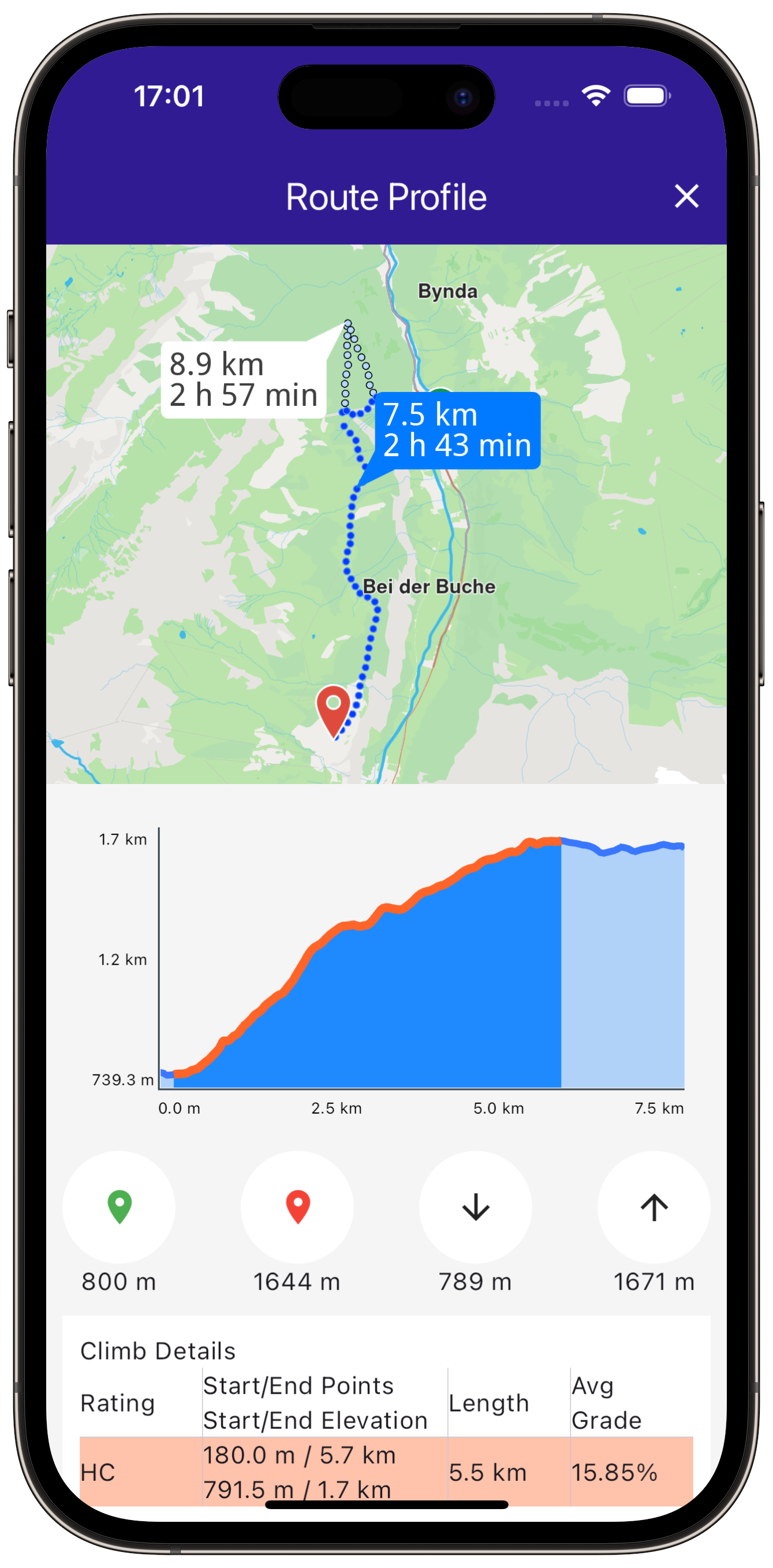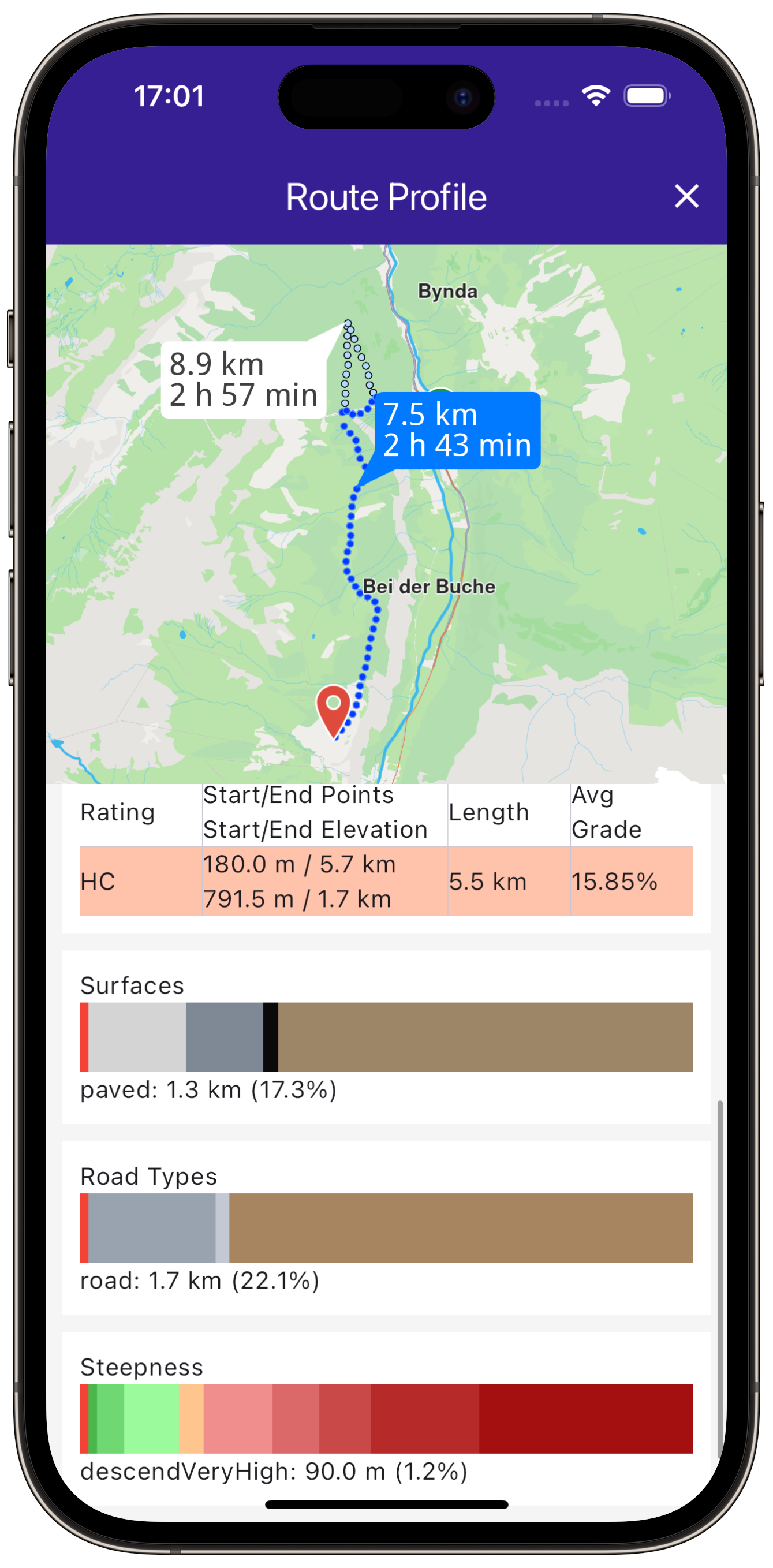Route Profile¶
In this guide you will learn how to display a map, calculate routes between multiple points, and show a detailed route profile.
|
|
Setup¶
Prerequisites¶
Build and Run¶
Start a terminal/command prompt and navigate to the route_profile directory within the Flutter examples directory. This is the name of the example project.
Note - the gem_kit directory containing the Maps SDK for Flutter
should be in the plugins directory of the example, e.g.
example_pathname/plugins/gem_kit - see the environment setup guide above.
Run: flutter pub get
Configure the native parts:
First, verify that the ANDROID_SDK_ROOT environment variable
is set to the root path of your android SDK.
In android/build.gradle add the maven block as shown,
within the allprojects block, for both debug and release builds:
allprojects {
repositories {
google()
mavenCentral()
maven {
url "${rootDir}/../plugins/gem_kit/android/build"
}
}
}
in android/app/build.gradle
within the android block, in the defaultConfig block,
the android SDK version minSdk must be set as shown below.
Additionally, for release builds, in android/app/build.gradle,
within the android block, add the buildTypes block as shown:
Replace example_pathname with the actual project pathname
android {
defaultConfig {
applicationId "com.magiclane.gem_kit.examples.example_pathname"
minSdk 21
targetSdk flutter.targetSdk
versionCode flutterVersionCode.toInteger()
versionName flutterVersionName
}
buildTypes {
release {
minifyEnabled false
shrinkResources false
// TODO: Add your own signing config for the release build.
// Signing with the debug keys for now, so `flutter run --release` works.
signingConfig signingConfigs.debug
}
}
}
Then run the project:
flutter run --debugorflutter run --release
Import Necessary Packages¶
First, import the required packages in your Dart code.
import 'package:gem_kit/core.dart';
import 'package:gem_kit/map.dart';
import 'package:gem_kit/routing.dart';
import 'package:flutter/material.dart' hide Route;
import 'elevation_chart.dart';
import 'route_profile_panel.dart';
App entry and initialization¶
const projectApiToken = String.fromEnvironment('GEM_TOKEN');
void main() {
runApp(const MyApp());
}
This code initializes the projectApiToken with the required authorization token and launches the app.
How it Works¶
This example demonstrates the following key features:
Calculates routes and renders them on the map.
Display detailed route profile, including an elevation chart that visualizes the terrain along the route.
|
|||
Build the Main Application¶
Define the main application widget, MyApp.
class MyApp extends StatelessWidget {
const MyApp({super.key});
@override
Widget build(BuildContext context) {
return const MaterialApp(
debugShowCheckedModeBanner: false,
title: 'Route Profile',
home: MyHomePage(),
);
}
}
Handle Maps and Routes in the Stateful Widget¶
Create the stateful widget, MyHomePage, which will handle the map and routing functionality.
class MyHomePage extends StatefulWidget {
const MyHomePage({super.key});
@override
State<MyHomePage> createState() => _MyHomePageState();
}
Define State Variables and Methods¶
Within _MyHomePageState, define the necessary state variables and methods to interact with the map and manage routes.
class _MyHomePageState extends State<MyHomePage> {
late GemMapController _mapController;
TaskHandler? _routingHandler;
Route? _focusedRoute;
final LineAreaChartController _chartController = LineAreaChartController();
@override
void dispose() {
GemKit.release();
super.dispose();
}
@override
Widget build(BuildContext context) {
return Scaffold(
appBar: AppBar(
backgroundColor: Colors.deepPurple[900],
title: const Text('Route Profile', style: TextStyle(color: Colors.white)),
actions: [
if (_routingHandler == null && _focusedRoute == null)
IconButton(
onPressed: () => _onBuildRouteButtonPressed(context),
icon: const Icon(Icons.route, color: Colors.white),
),
if (_routingHandler != null)
IconButton(
onPressed: () => _onCancelRouteButtonPressed(),
icon: const Icon(Icons.stop, color: Colors.white),
),
if (_focusedRoute != null)
IconButton(
onPressed: () => _onClearRoutesButtonPressed(),
icon: const Icon(Icons.clear, color: Colors.white),
),
],
),
body: Stack(
children: [
GemMap(
onMapCreated: _onMapCreated,
),
if (_focusedRoute != null)
Align(
alignment: Alignment.bottomCenter,
child: RouteProfilePanel(
route: _focusedRoute!,
mapController: _mapController,
chartController: _chartController,
centerOnRoute: () => _centerOnRoute([_focusedRoute!]),
))
],
),
);
}
void _onMapCreated(GemMapController controller) {
_mapController = controller;
_registerRouteTapCallback();
}
void _onBuildRouteButtonPressed(BuildContext context) {
final departureLandmark =
Landmark.withLatLng(latitude: 46.59344, longitude: 7.91069);
final destinationLandmark =
Landmark.withLatLng(latitude: 46.55945, longitude: 7.89293);
final routePreferences = RoutePreferences(
buildTerrainProfile: const BuildTerrainProfile(enable: true),
transportMode: RouteTransportMode.pedestrian);
_showSnackBar(context, message: "The route is being calculated.");
_routingHandler = RoutingService.calculateRoute(
[departureLandmark, destinationLandmark], routePreferences,
(err, routes) {
_routingHandler = null;
ScaffoldMessenger.of(context).clearSnackBars();
if (err == GemError.success) {
final routesMap = _mapController.preferences.routes;
for (final route in routes!) {
routesMap.add(route, route == routes.first,
label: route.getMapLabel());
}
_centerOnRoute(routes);
setState(() {
_focusedRoute = routes.first;
});
}
});
setState(() {});
}
void _onClearRoutesButtonPressed() {
_mapController.deactivateAllHighlights();
_mapController.preferences.routes.clear();
setState(() {
_focusedRoute = null;
});
}
void _onCancelRouteButtonPressed() {
if (_routingHandler != null) {
RoutingService.cancelRoute(_routingHandler!);
setState(() {
_routingHandler = null;
});
}
}
void _registerRouteTapCallback() {
_mapController.registerTouchCallback((pos) async {
_mapController.setCursorScreenPosition(pos);
final routes = _mapController.cursorSelectionRoutes();
if (routes.isNotEmpty) {
_mapController.preferences.routes.mainRoute = routes.first;
if (_chartController.setCurrentHighlight != null) {
_chartController.setCurrentHighlight!(0);
}
setState(() {
_focusedRoute = routes.first;
});
_centerOnRoute([_focusedRoute!]);
}
});
}
void _centerOnRoute(List<Route> route) {
const appbarHeight = 50;
const padding = 20;
_mapController.centerOnRoutes(route,
screenRect: RectType(
x: 0,
y: (appbarHeight + padding * MediaQuery.of(context).devicePixelRatio)
.toInt(),
width: (MediaQuery.of(context).size.width *
MediaQuery.of(context).devicePixelRatio)
.toInt(),
height: ((MediaQuery.of(context).size.height / 2 -
appbarHeight -
2 * padding * MediaQuery.of(context).devicePixelRatio) *
MediaQuery.of(context).devicePixelRatio)
.toInt(),
));
}
void _showSnackBar(BuildContext context,
{required String message, Duration duration = const Duration(hours: 1)}) {
final snackBar = SnackBar(
content: Text(message),
duration: duration,
);
ScaffoldMessenger.of(context).showSnackBar(snackBar);
}
}
This example guides you through the setup and implementation of a route profile in a Flutter application using the ``gem_kit``package. The focus is on handling maps, user interactions, and route preferences to provide a seamless user experience for calculating and displaying route profiles.




